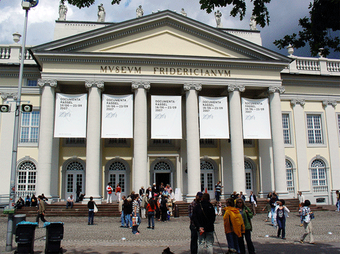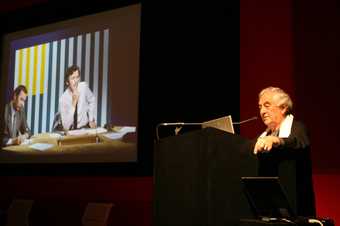
Fig.1
Museum Fridericianum during documenta 12 2007
Photograph © Simon Zirkunow
On 10 and 11 October 2008 we organised, with the support of the Jan van Eyck Academie, Maastricht, and other partners, an international conference devoted to the histories of exhibitions entitled Landmark Exhibitions: Contemporary Art Shows since 1968. At the time, the conference was, if not the first, certainly among the first attempts to review a field of historical research that had gone heretofore largely unnoticed: the phenomenological, sociological, affective, economic and political contexts that condition art’s presentation. The art object has for too long been considered in isolation, as a material artefact independent of the web of power relations in which it is produced, discussed, exchanged, stored and exhibited. Now, perhaps as a reflection of a larger environmental awareness, the art object can be seen as one element in a dynamic, time- and site-sensitive microcosm.
Not that art history has been blind to the economic and political factors informing the art work’s production. Feminist and Marxist historians in the 1970s taught us to view the art object in all its social complexity, bringing it out of the exclusive purview of the connoisseur, for whom the encounter with art was essentially that of individual, if not isolated, contemplative immersion and appreciation. Without meaning to fall into the trap of teleological post-hoc rationalisation – which the conference’s title, with its reference to historical ‘landmarks’, might suggest – one could argue that the attention to histories of exhibitions signals a shift on a par with that performed by the social art history three decades ago. However, where a social approach to art history remained very much in the hands of the trained expert, the histories of exhibitions open the analysis of the modalities of art’s contexts to a much broader circle of participants, including curators, museum professionals, archivists, collectors and enthusiasts of all stripes who frequent, among other exhibition spaces, art fairs, museums, galleries and biennials.
By beginning to explore the pre-eminent role exhibitions, in the widest sense, play in the formation of our understanding of art, but especially contemporary art, the conference aimed to make its modest contribution to this emerging field of historical analysis. At the same time, the decidedly immodest claim of exploring not just any exhibitions but those that were landmarks, clearly and consciously throws down the gauntlet to critics, historians and curators, asking for its presumption to be pricked. While attempting to stake a claim for the ground to be investigated, it also issues a challenge about the terms of this definition, about including or re-inserting what hegemonic discourse traditionally excluded: art beyond Europe and the USA, the non-Western, the non-White, and the non-hetero-normative. No less than a decentred geography, this ‘new’ field of enquiry challenges us to reconsider the temporal conventions of telling history: Where to start? Where to place the symbolic ‘year zero’ before and after which this history begins? Can a history be told without punctuation by landmark events – crises, catastrophes, successions – that allow it to appear, precisely, as a history and not as a motley assortment of disconnected points in time?

Fig.2
Daniel Buren during the Landmark Exhibitions conference at Tate Modern 2008
Photograph Miranda Gavin © Tate
The essays presented in this issue of Tate Papers – versions of papers first delivered at the Landmark Exhibitions conference – address these questions, providing different historiographic models with which to begin to discuss the field of exhibition histories. But beyond a core epistemological challenge – that of delineating the still imprecise contours of this field – what stands out from the texts in this issue is their methodological diversity, pointing to this field’s inclusive potential: in the absence of a fixed canon, in an era in which Europe and the USA no longer hold the monopoly of knowledge production, the history of exhibitions has been immediately subject to the kind of scrutiny reserved for more mature discourses, rendering the plural – exhibition histories – inescapable. If evidence were needed to illustrate the radically altered landscape in which exhibition histories are now taking shape, we can point to those conferences that started to unpick the seams of the landmark-based history tentatively sketched at Exhibitions and the World at Large at Tate Britain in April 2009 and Invisible History of Exhibitions: Parallel Chronologies organised by tranzit.org in Budapest in May 2009.
Both the variety of approaches demonstrated in the texts collected here and the impulse to open exhibition histories beyond Western Euro-American spheres of influence indicate that this expanding field might not only correct a long-standing art historical blind spot – namely the architectural and social contexts in which works of art are shown, discussed, emulated and critiqued – but also assert itself as capable of contending with the changed political and economic geographies of the first decades of the twenty-first century.
